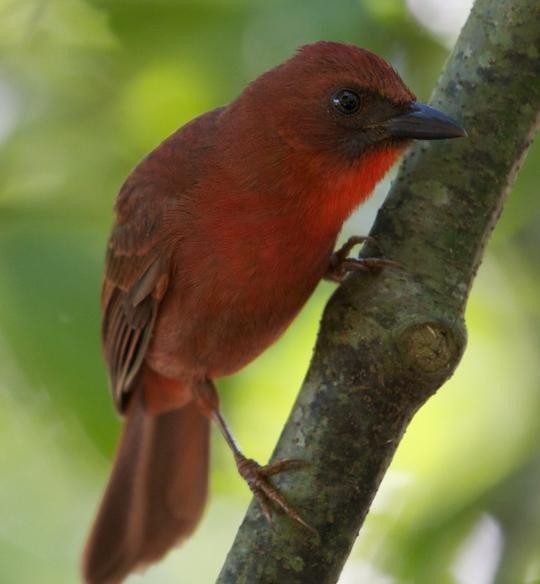Red-throated Ant-tanager
A species of Ant Tanagers Scientific name : Habia fuscicauda Genus : Ant Tanagers
Red-throated Ant-tanager, A species of Ant Tanagers
Botanical name: Habia fuscicauda
Genus: Ant Tanagers
Content
Description General Info
 Photo By Habia_fuscicauda_-Belize-8.jpg , used under CC-BY-2.0 /Cropped and compressed from original
Photo By Habia_fuscicauda_-Belize-8.jpg , used under CC-BY-2.0 /Cropped and compressed from original Description
The red-throated ant tanager (Habia fuscicauda) is a medium-sized passerine bird. This species is a resident breeder on the Caribbean slopes from southeastern Mexico to eastern Panama. It was usually considered an aberrant kind of tanager and placed in the Thraupidae, but is actually closer to the cardinals (Cardinalidae). Consequently, it can be argued that referring to the members of this genus as ant tanagers is misleading, but no other common name has gained usage. Red-throated ant tanagers are 19 cm (7.5 in) long and weigh 40 g (1.4 oz). Adult males are dull dusky red, somewhat paler below, and with a bright red throat and central crown. The female is brownish olive, paler and greyer below, and with a yellow throat and small dull yellow crown stripe. Young birds are brown and lack the throat and crown patches. Both sexes of this species are duller and darker than the related red-crowned ant tanager which occurs on the Pacific slope in its Central American range. It occurs in thick undergrowth at the edge of forest, second growth or abandoned plantations at altitudes from sea level to 600 m (2,000 ft). The large but untidy cup nest is usually built 1–3 m (3.3–9.8 ft) high in the fork of a shrub or tree, and is often decorated with living ferns. The normal clutch is two or three white eggs laid from April to June. These birds are found in pairs or small groups. They eat insects, arthropods and fruit like those of Cymbopetalum mayanum (Annonaceae), and less often Trophis racemosa (Moraceae), and will follow army ant columns especially in lowlands where antbirds are uncommon. The flock will give a defensive spread-wing-and-tail display to deter potential predators. There are six known subspecies: H. f. salvini – (von Berlepsch, 1883): found from eastern Mexico to El Salvador H. f. insularis – (Salvin, 1888): found in the Yucatan Peninsula (southeastern Mexico) and northern Guatemala H. f. discolor – (Ridgway, 1901): found in northeastern, central and eastern Nicaragua H. f. fuscicauda – (Cabanis, 1861): nominate, found from southern Nicaragua to western Panama H. f. willisi – Parkes, 1969: found in central Panama H. f. erythrolaema – (Sclater, PL, 1862): found in northern Colombia 
Size
20 cm
Nest Placement
Shrub
Feeding Habits
Red-throated Ant-tanager primarily feeds on insects, small arthropods, and fruit, occasionally including small lizards in their diet. Red-throated Ant-tanager forages in the understorey, adept at searching for prey among leaves and branches. Unique adaptations include a specialized bill for gleaning insects from foliage.
Habitat
Red-throated Ant-tanager principally inhabits the understory of both humid and semiarid forests, ranging from evergreen to semideciduous types. These birds are also prevalent in secondary growth forests, various woodlands, and dense thickets. Red-throated Ant-tanager predominantly occurs within lower elevations up to 1200 meters, though they are most frequently observed below 1000 meters. Their habitat spans across broad tropical regions.
Dite type
Insectivorous
General Info
Feeding Habits
Bird food type
Species Status
Not globally threatened.

 Photo By Habia_fuscicauda_-Belize-8.jpg , used under CC-BY-2.0 /Cropped and compressed from original
Photo By Habia_fuscicauda_-Belize-8.jpg , used under CC-BY-2.0 /Cropped and compressed from original Scientific Classification
Phylum
Chordates Class
Birds Order
Perching birds Family
Cardinals Genus
Ant Tanagers Species
Red-throated Ant-tanager